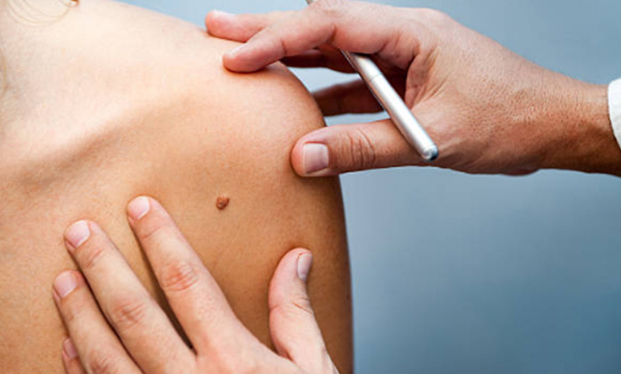Non-Melanoma Skin Cancer Removal
Serving Hamilton, Stoney Creek, Grimsby and surrounding areas.
- The most common skin cancer removed in my office is Basal Cell Carcinoma (BCC).
- The second most common skin cancer that I remove is Squamous Cell Carcinoma (SCC)
- Basal Cell Carcinomas and Squamous Cell Carcinomas are called “Non-Melanoma” Skin Cancers.
- Basal Cell Carcinomas may be classified as either simple or complicated.
Preparation
- You may eat normally prior to the procedure.
- Take your medications as prescribed by your doctor.
- You will be able to drive home or use public transportation after the procedure.
Electrodessication and Curettage (All Types of BCC and Small SCC)
- The skin around the lesion is injected with a local anesthetic to numb the area.
- The injection stings for a few seconds. After this, there is no pain or discomfort.
- The lesion is removed from the skin in a scraping motion with an instrument called a curette.
- As the area is numb from the anesthetic, this process is not painful.
- The curetted area is then treated with electrocautery, a hot electric needle. This is not painful as the area is still numb.
- Electrocautery stops any bleeding and kills any residual cancer cells.
- The lesion is scraped and cauterized a total of 3 times in one visit.
- No stitches are required.
- Antibiotic and a bandage are used to cover the wound.
- The day after surgery, the bandage should be removed and a small amount of antibiotic should be be applied. This should occur twice daily site is healed, for about two weeks.
- Redness, pain, swelling or a discharge from the wound may be a sign of infection. The doctor should be informed immediately.
- You may bathe, shower and do your normal activities unless the non-melanoma skin cancer that has been removed is very large and there is a risk of the wound being damaged. The doctor will inform you about this.
- There is a small chance that the lesion could grow back.
Surgical Excision (All types of BCC and SCC)
- The skin around the lesion is injected with a local anesthetic to numb the area.
- The injection stings for a few seconds. After this, there is no pain or discomfort.
- The non-melanoma skin cancer and a small amount of surrounding normal skin is cut with a scalpel and removed.
- As the area is numb from the anesthetic, this process is not painful.
- Stitches are used to close the opening.
- Antibiotic and a bandage are used to cover the wound.
- The day after surgery, the bandage should be removed and a small amount of antibiotic should be be applied. This should occur twice daily until the stitches are removed.
- Redness, pain, swelling or a discharge from the wound may be a sign of infection. The doctor should be informed immediately.
- The stitches are removed in 5 to 10 days.
- The removal of stitches is painless.
- You may bathe, shower and do your normal activities unless the lesion that has been removed is very large and there is a risk of the wound being damaged. The doctor will inform you about this.
- There is a small chance that the non-melanoma skin cancer could grow back.
Radiation (All types of BCC and SCC)
- To receive radiotherapy of a basal cell carcinoma or squamous cell carcinoma, the lesion must be biopsied first.
- To do the biopsy:
- The skin around the lesion is injected with a local anesthetic to numb the area.
- The injection stings for a few seconds. After this, there is no pain or discomfort.
- A small portion of the lesion is removed.
- As the area is numb from the anesthetic, this process is not painful.
- Stitches are usually not necessary to close the opening.
- The biopsied area is then treated with electrocautery, a hot electric needle. This is not painful as the area is still numb.
- The electrocautery is used to stop any bleeding.
- Antibiotic and a bandage are used to cover the wound.
- The day after surgery, the bandage should be removed and a small amount of antibiotic should be be applied for 1 week.
- Redness, pain, swelling or a discharge from the wound may be a sign of infection. The doctor should be informed immediately.
- If stitches were used, they are removed in 5 to 10 days.
- The removal of stitches is painless.
- You may bathe, shower and do your normal activities after the biopsy.
- Once the biopsy result is available the doctor will make a referral to a radiation specialist.
- In Hamilton the radiation treatments and specialists are located at the Juravinski Cancer Centre next to the Henderson General Hospital.
- The first visit with the radiation specialist if for an assessment only.
- If he or she agrees with your doctor that the lesion is suitable for radiation, treatments will be arranged.
- Most non-melanoma skin cancers required 10 to 15 treatments. These are done daily, Monday to Friday over a period of 2 to 3 weeks.
- After the radiation is complete, the spot will become red, scabby and crusted.
- This will heal over the next few weeks.
- There is a small chance that the lesion could grow back.
Mohs Micrographic Surgery (Complicated BCC and Complicated SCC)
- Mohs micrographic surgery is a detailed surgical procedure to treat aggressive non-melanoma skin cancers, mainly on the face and neck.
- This treatment is usually reserved for the most complicated cases.
- I refer my patients from the Hamilton area, to the Mohs Centre at Women’s College Hospital in Toronto.
- Initially, the diagnosis must been confirmed with a biopsy (see above), prior to the referral being made

